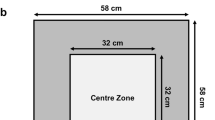Abstract
Rats received subcutaneous injections of either nicotine (NIC; 0.05–0.8 mg/kg) or vehicle [VEH (phosphate buffer); 1 ml/kg] immediately after conditioning sessions in a place-conditioning paradigm (delay conditioning). NIC was paired for three delay-conditioning sessions with one environment of a three-compartment place-conditioning apparatus; VEH was paired with another environment. The subjects were then tested for place preference or aversion by determining the proportion of time spent in each compartment during a 15-min test session. Delay conditioning with NIC only produced a dose-related place aversion (greater time was spent in the VEH-paired chamber on test day). Place aversion was evident when NIC, 0.8 mg/kg, was administered either immediately or 5 min after conditioning sessions but not when given 15 min after conditioning. Chlorisondamine (5 μg, lateral ventricle), but not saline, administered 2 weeks prior to delay conditioning with 0.8 mg/kg NIC completely blocked the NIC-induced place aversion. These data suggest that delay conditioning with NIC produces place aversion by a central mechanism. Since standard conditioning (NIC injection immediately before the place-conditioning sessions) with NIC only produced dose-related place preferences (Fudala et al. 1985; Fudala and Iwamoto 1986), the time of administration of the unconditioned stimulus is a strong determinant of the place-conditioning effects of NIC.
Similar content being viewed by others
References
Bardo MT, Miller JS, Neisewander JL (1984) Conditioned place preference with morphine: The effect of extinction training on the reinforcing CR. Pharmacol Biochem Behav 21:545–549
Blander A, Hunt T, Blair R, Amit Z (1984) Conditioned place preference: An evaluation of morphine's positive reinforcing properties. Psychopharmacology 84:124–127
Bugelski BR (1979) Principles of learning and memory. Praeger, New York
Clarke PBS (1984) Chronic central nicotinic blockade after a single administration of the bisquaternary ganglionic-blocking drug chlorisondamine. Br J Pharmacol 83:527–535
Clarke PBS, Kumar R (1983) Characterization of the locomotor stimulant action of nicotine in tolerant rats. Br J Pharmacol 80:587–594
Fudala PJ, Iwamoto ET (1986) Further studies on nicotine-induced conditioned place preference in the rat. Pharmacol Biochem Behav 25:1041–1049
Fudala PJ, Teoh KW, Iwamoto ET (1985) Pharmacologic characterization of nicotine-induced conditioned place preference. Pharmacol Biochem Behav 22:237–241
Mackintosh NJ (1974) The psychology of animal learning. Academic, New York
Martin BR, Tripathi HL, Aceto MD, May EL (1983) Relationship of the biodisposition of the stereoisomers of nicotine in the central nervous system to their pharmacological actions. J Pharmacol Exp Ther 226:157–163
The Merck Index (1983) Windholz M (ed), 10th edition. Merck, Rahway
Morrison CF, Goodyear JM, Sellers CM (1969) Antagonism by antimuscarinic and ganglionic-blocking drugs of some of the behavioral effects of nicotine. Psychopharmacology 15:341–350
Mundy WR, Iwamoto ET (1986) Behavioral effects of nicotine in three models of memory and learning in rats. Toxicologist 6(1):215
Neter J, Wasserman W (1977) Applied linear statistical models. Irwin, Homewood
Paxinos G, Watson C (1982) The rat brain in stereotaxic coordinates. Academic, New York
Plummer AJ, Trapold JH, Schneider JA, Maxwell RA, Earl AE (1955) Ganglionic blockade by a new bisquaternary series, including chlorisondamine dimethochloride. J Pharmacol Exp Ther 115:172–184
Rosecrans JA, Schechter MD (1972) Brain area nicotine levels in male and female rats of two strains. Arch Int Pharmacodyn 196:46–54
SAS Institute, Inc. (1982) SAS user's gulde: Statistics, 1982 edition. SAS Institute, Cary, NC
Schwartz B (1978) Psychology of learning and behavior. Norton, New York
Sherman JE, Pickman C, Rice A, Liebeskind JC, Holman EW (1980) Rewarding and aversive effects of morphine: Temporal and pharmacological properties. Pharmacol Biochem Behav 13:501–505
Spyraki C, Kazandjian A, Varonos D (1985) Diazepam-induced place preference conditioning: Appetitive and antiaversive properties. Psychopharmacology 87:225–232
Author information
Authors and Affiliations
Rights and permissions
About this article
Cite this article
Fudala, P.J., Iwamoto, E.T. Conditioned aversion after delay place conditioning with nicotine. Psychopharmacology 92, 376–381 (1987). https://doi.org/10.1007/BF00210847
Received:
Revised:
Issue Date:
DOI: https://doi.org/10.1007/BF00210847




